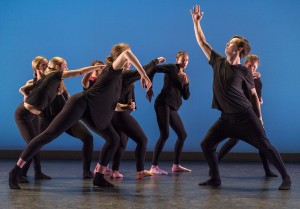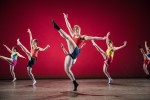Electronic dance music, Mexican female warriors, neurological phenomena, the ocean and consumerism find common ground in the Glorya Kaufman Dance Theater.
Undergraduates of the UCLA Department of World Arts and Cultures/Dance have been preparing since September for this year’s Wacsmash performance, titled “Fingers,” which will take place Friday and Saturday. The show consists of 10 pieces by 47 student choreographers and performers.
Wacsmash started in 2000 as a student-run opportunity for undergraduate students to share their original works. The pieces for this year’s show confront larger social concepts, including social media influence, commercialism versus abstraction in dance and femininity, Wacsmash co-producer Morgan Hood said.
The (See)d
The choreographed number “The (See)d” sprouted from ideas of consumerism in an age of information, and it blossoms into 6.5 minutes of abrupt movement changes, Hood said.
Hood and Natalee Palmer, both fourth-year dance and sociology students, said they wanted to explore the world of consumerism through dance and music.
“I was inspired to create a piece about how ideas and commercials are planted in our minds and how we are impacted by societal pressures to buy or wear certain things,” Palmer said. “We’re constantly bombarded with information.”
The dancers share eye contact and carry each other, demonstrating different kinds of connections, only to be interrupted by the blaring commercials.
The disjointed choreography was inspired by the jarring experience of hearing an advertisement while listening to commercial music streaming services like Pandora, she said.
“Bon Iver would play when they were choreographing, which led to more fluid connection of movements,” Hood said. “Then, Rihanna’s ‘Work’ would play right after, so that led to us incorporating different styles of dance and different movements like wrist-flicking into our piece.”
The choreography is set to a soundtrack of songs, GEICO commercials, Mercedes Benz commercials, a “Mr. Robot” snippet and new clips layered over each other, Hood said.
Dancers will dress in all-American clothes like plain white T-shirts and khakis in order to demonstrate the choreography’s theme of conformity. They dance in graceful turns and extensions, then switch to grungy moves brought about by contact improvisation – like lifts and weight-sharing – to represent the constant interruptions in life, Palmer said.
The intention of the layering is to make the viewer feel frustrated and even crowded by the input they’re receiving while watching the dance, Hood said. She added this makes them aware of all the information around them and how they can receive that information.
“I want them to think about whether we are conditioned to act and think in a certain way because of the information that surrounds us, or if we are actually making our own decisions,” Palmer said.
Old Days
Matthew Rogers’ piece “Old Days” derives from his passion for EDM. The piece – which will be performed to Rogers’ favorite song “Old Days” by Yellow Claw and San Holo – aims to make the audience rethink the ways they listen to music and reconsider their initial ideas about the types of music commonly associated with contemporary dance, said Rogers, a third-year dance student.
“I like working with EDM because there are so many layers which I can pick and choose from to choreograph my pieces,” he said.
Rogers said he chose this song primarily for its multidimensionality – its different tonalities, harmonies and beats – and its contrast to what most people think contemporary dance should be performed to, which are usually acoustic guitar songs with lyrics.
He feels he can explore the different parts of Yellow Claw and San Holo’s song and draw attention to parts that would be left overlooked by having dancers accent bass drops and beats with isolated, jagged movements.

The choreography will also feature formations where the dancers move in isolation away from the rest of the group, he said.
In one instance in the piece, a dancer moves to a punctuated one-two-three beat of “Old Days,” away from the rest of the group, performing gooey and wavy, internalized movements that replicate the flow of the bass drop, Rogers said.
In addition to drawing inspiration from the energetic music, Rogers also incorporated EDM’s rave culture into his piece, he said.
His dancers will don red bandanas like those people wear to raves. His choreography also includes an improvisatory section toward the end of the piece. This allows his 10 performers to jam out as they would if they were at a music festival, he said.
“Within this piece, I feel nothing but waves of release, energy and euphoria,” he said. “And I hope the audience feels that too.”
seascape.
“seascape.” attempts to imitate the movement of ocean waves and aims to draw out a range of emotions people may experience when in contact with the ocean, co-choreographer Diana Gilmore said.
She said the piece was choreographed based on her own feelings of admiration and curiosity for the ocean. Gilmore’s feelings further developed during her semester spent at sea, where she was in contact with the ocean everyday.
“That does not mean the meaning and perception of the piece should be limited to just my feeling – it will be different for each person,” said Gilmore, a fourth-year dance and economics student.

Her choreography’s chaotic, more fast-paced movements of big jumps and deep lunges represent the more extreme stormy waves, she said. While her choreography may provoke fear of the power of the ocean in some, others may feel a memory of a past or current relationship, Gilmore said.
The dancers wear breathable, olive turtlenecks as a textured blue light shines overhead, she said.
“I want people to come out of the experience not ‘getting’ what the piece is about, as we tend to do with art, but rather just ‘feeling’ something toward the dance and what it could possibly be portraying,” Gilmore said. “I want everyone to go for a ride with this piece regardless of what I felt during the piece.”
Medium Rare
Jocelyn Reyes explores the sweet spot between familiar and unfamiliar spaces in her piece “Medium Rare.”
The fourth-year dance and cognitive science student finds inspiration in disconnections and explores the feeling of moving inbetween familiar and unfamiliar spaces, she said.
To demonstrate the notion of there being two sides of a story, the piece has a funky, silly section where the dancers bend over their bodies and create circles by whipping their hair around to contrast with the more curved and gestural modern and postmodern movements at the beginning, Reyes said.
“I think the title reflects that nice middle ground in being able to see both,” Reyes said.
Reyes said she experienced the unfamiliarity every time she went home from college for quarter breaks. Each time she returned after being away, she said her once-familiar home seemed like it had changed in ways she couldn’t identify.
Mi Mujer
Elizabeth Rodriguez pays tribute to the mothers, sisters, daughters and wives in her life in her piece, “Mi Mujer.”
The piece is an homage to the strong women in her life, including her mother, sister, aunts, mentor and revolutionary female soldiers of the early 20th century, called guerreras.
“These women are my rocks and are also responsible for who I have become today,” Rodriguez said. “They are fierce and I wanted to create a piece that represents that.”
Rodriguez will combine dance styles from her background, such as salsa and its one-two-three rhythms, with house and waacking movements to display the women’s fierceness, said the fourth-year dance and Spanish student.
“These women helped me define what it means to be a woman of color and this piece encompasses all they’ve done for me,” Rodriguez said.
With the many social and ideological themes present in this year’s Wacsmash pieces, Hood hopes viewers will look at the dances for their narratives and as more than a performance of bodies on stage, she said.
“We want to share that dance is a form of expression and a form of communication as much as it is an art,” Hood said.
